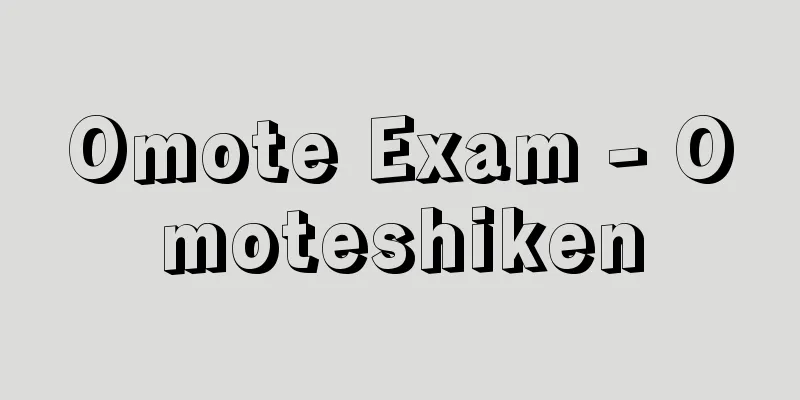Electric motor

|
A general term for energy conversion devices that convert electrical energy into mechanical energy. They are also called motors. They can be divided into direct current and alternating current depending on the power source, but the principle is the same. When a conductor with a length of l meters is placed perpendicular to a magnetic field with a magnetic flux density of B Tesla and a current of i amperes is passed through it, a force of B · l · i Newtons is generated in the conductor. [Naoyoshi Isobe and Masayuki Morimoto] Early electric motorsThe first electric motors were made around 1831, when electromagnetic induction was discovered by M. Faraday. However, it is said that the early motors mainly used the attraction and repulsion of permanent magnets to make the moving part oscillate rather than rotate. The first modern DC motors, using an armature and electromagnets excited by DC, were made by Moritz Hermann von Jacobi (1801-1874) in 1834 and Robert Davidson (1804-1894) in 1837, but both had low output and were still in the laboratory stage. After several decades, the age of AC power generation became established, and there was a demand for electric motors that could be operated directly by AC power sources. G. Ferraris of Italy and N. Tesla of Croatia discovered a rotating magnetic field created by AC, which led them to independently create the two-phase AC motor. Currently, most AC motors use three-phase AC, and the first such motor is said to have been a 100-watt motor made by Germany's Dolibo Dobrovolsky in 1889. The first DC motor made in Japan is said to have been a 15-kilowatt motor made in 1855 (Ansei 2) (according to "The History of the Electrical Industry of Japan" published by the Japan Electrical Manufacturers' Association), but three-phase induction motors were made much later, with a 0.75-kilowatt motor made in 1899 (Meiji 32). Three-phase synchronous motors were made even later, in 1915 (Taisho 4), but at that time six large-output 550-kilowatt, 6,000-volt motors were made. [Naoyoshi Isobe and Masayuki Morimoto] Motor TypeIn principle, electric motors can also be used as generators. A generator converts mechanical power into electrical energy, but conversely, if electrical power is supplied to a generator, mechanical power is generated. In general, electric motors and generators have the same principles and structure, so they are collectively referred to as induction motors (induction motors) and induction generators (DC generators) and DC motors (DC motors). Electrical equipment, including electric motors and generators, can be classified as follows according to the type of power voltage applied to the terminals (DC or AC) and whether there is a fixed relationship between the power supply frequency and the rotational speed (synchronous). [1] DC Machine (2) Separately excited separately excited DC machine, permanent magnet DC machine. [2] AC Machine (2) Induction machines (asynchronous machines) Squirrel-cage induction machine, wound-rotor induction machine, single-phase induction machine. (3) AC commutator (universal motor). [Masayuki Morimoto] Motor Speed and ControlDepending on the application, the speed of a motor may be desired to be constant or nearly constant, or may be desired to be able to change the speed over a wide range. When examining the characteristics of each motor from this perspective, the following can be found. [1] DC motor The speed is roughly proportional to the voltage applied to the armature, and inversely proportional to the amount of magnetic flux generated in the magnetic poles. Therefore, if it is operated at a constant voltage and constant excitation, the speed will drop slightly when the load is heavy, but it can be operated at a roughly constant speed. To change the speed, you can either keep the excitation constant and change the voltage applied to the armature, or keep the voltage constant and change the excitation. The former is called voltage control of speed, and the latter is called field control. Both can also be used together. DC motors can be classified according to the excitation method into separate excitation type, shunt winding type, compound winding type, and series winding type. (1) Separately excited motors: The field and armature are separate power sources. Either armature voltage control or field control can be applied. This convenience makes up for the drawbacks of DC motors, such as high cost and troublesome maintenance, and high-output separately excited motors are still valued and used today. (2) Shunt winding: The field winding and armature winding are connected in parallel. To maintain the field current, the armature voltage is kept constant during operation. Speed control is by field control, but the ratio of maximum speed to minimum speed can be controlled within a range of about 3. (3) Compound winding There are two types of field windings. One is the same as the shunt winding, and the other is a field winding with a large cross-sectional area and few turns so that armature current can flow, which is called a series wound field. These two field windings are wound around each pole core, so it is called a compound winding. This motor is also used at a constant voltage, and speed control is performed by field control. (4) Series wound type: The field winding and armature winding are connected in series. When a certain voltage is applied and the load is increased, the armature current increases, the magnetic flux increases, the speed decreases, and the torque (rotational force) increases. When this type of motor is operated with a constant voltage power supply, a resistor is placed in series with the armature and the speed is controlled by changing this resistance. With a variable voltage power supply, the voltage can be changed, and the control of series wound motors used in electric railways by a chopper (a device that passes and cuts off direct current) involves creating a variable voltage from a constant voltage power supply through the chopper and applying it to the motor. [2] Synchronous motors can only operate at a synchronous speed proportional to the frequency, so when operated with a constant frequency (commercial frequency) power source of 50 or 60 Hz, they can only operate at a constant speed. However, if a variable frequency power source is used, variable speed proportional to the frequency can be obtained. Since the 1980s, advances in power electronics have led to the spread of variable frequency inverters, and there are increasing examples of variable speed operation of synchronous motors. [3] Induction motors When these motors are operated with a constant frequency power source, the speed only drops slightly even if the load increases, so they are included in the category of constant speed motors. If you want to control the speed, with a wound motor, you can add or remove resistors in series with each phase of the secondary circuit, but it is difficult to control over a wide range. There are also methods of controlling the speed by inserting thyristors, DC motors, inverters, etc. into the secondary circuit, and there are examples of these being used in large capacity machines. To change the speed of a squirrel-cage motor over a wide range, more and more motors are being powered by variable frequency inverters. The primary winding can be specially configured to change the number of poles, for example, 2-pole, 4-pole, 4-pole, 8-pole, etc., to change the synchronous speed, but this is only a speed change and does not allow continuous speed control. [Naoyoshi Isobe and Masayuki Morimoto] Other electric motors(1) AC commutator motor: An AC motor with a commutator like a DC motor. There are three-phase and single-phase. Three-phase motors come in shunt and series-wound types, and both types allow the speed to be changed over a wide range by moving electric brushes. They were once widely used because they could be run directly from an AC power source and could provide speed control on a par with DC motors, but since the 1980s, power electronics have made it easier to control the speed of AC motors, so three-phase AC commutator motors are rarely used anymore. Among the three-phase shunt motors, those with the primary winding on the rotor side are called Schrage motors, and can be considered a variation of three-phase induction motors. A voltage of slip frequency taken from the commutator surface on the rotor side through brushes is applied to the secondary winding of the stator, and the magnitude of this voltage is changed by moving the brushes to change the speed. The speed range is often 50% above or below the synchronous speed, and infinitely variable speed is possible within this range. Stator-fed three-phase shunt motors use a three-phase induction voltage regulator as an accessory, which changes the rotor position but controls the speed without moving the motor brushes. Three-phase series-wound commutator motors have a large starting torque like series-wound DC motors, and infinitely variable speed is possible by changing the brush position, but they have poor commutation and are prone to sparks. Single-phase commutator motors are also available in shunt and series wound types, but the former have poor characteristics and have rarely been used in the past. Small capacity series wound types are used in vacuum cleaners, mixers, electric drills, and other devices that require high speed operation. These motors do not move brushes, and the speed is controlled by changing the applied voltage. A single-phase commutator motor designed to be used with either AC or DC is called a universal motor. Single-phase series-wound motors were once used in trains and electric locomotives in Europe. A low frequency such as 25 hertz or 50/3 hertz is used to reduce induced electromotive force. In the case of trains, each car is equipped with four motors, each with a capacity of 150 to 250 kilowatts. In many cases, the overhead line voltage is 15,000 volts, and a transformer is installed inside the car with many taps on the primary or secondary side, and the speed is controlled by changing the voltage applied to the motor by switching between them. (2) Commutatorless motor By combining a three-phase synchronous motor with an inverter or cycloconverter and applying a variable frequency AC voltage to the motor, it becomes possible to operate the motor at a wide range of variable speeds. This system is called a commutatorless motor, since it is a motor without a commutator. It is also called a brushless motor or a thyristor motor. There are also large commutatorless motors in the several thousand kilowatt class. Since the 1980s, motors that use permanent magnets as a field magnet and are driven by inverters have come to be called brushless motors. Brushless motors have characteristics similar to DC motors. [Naoyoshi Isobe and Masayuki Morimoto] "Handbook of Electrical Engineering, 7th Edition (2013)" edited and published by the Institute of Electrical Engineers of Japan [Reference] | | | | |©Shogakukan "> Motor configuration Source: Shogakukan Encyclopedia Nipponica About Encyclopedia Nipponica Information | Legend |
|
電気エネルギーを機械エネルギーに変換するエネルギー変換機器の総称。モーターmotorともいう。電源により直流と交流とに分けられるが、原理は同じで、磁束密度がBテスラの磁界内に磁界と直角に長さlメートルの導体を置き、これに電流iアンペアを流すとき、その導体にB・l・iニュートンの力を生ずるということを利用している。 [磯部直吉・森本雅之] 初期の電動機電動機の形をなしたものとしては、M・ファラデーによって電磁誘導が発見された1831年ころからつくられている。ただし、初期のものは永久磁石の吸引・反発の力を利用して、可動部は回転でなく、揺動させる方式が主流だったといわれている。現在の直流電動機のように電機子と直流励磁した電磁石を用いた形は、1834年に発表されたヤコビMoritz Hermann von Jacobi(1801―1874)の電動機や、デビッドソンRobert Davidson(1804―1894)が1837年につくったものが最初といわれているが、いずれも出力が小さく、研究室段階のものであった。数十年を経て、交流による発電が定着する時代に入り、交流電源によって直接運転できる電動機が望まれ、イタリアのG・フェラリスやクロアチアのN・テスラらによって交流からつくられる回転磁界が発見され、これが端緒となって2人が独自に二相交流電動機をつくりあげた。現在、交流電動機の主流は三相交流を用いているが、これはドイツのドリボ・ドブロボルスキーが1889年につくった出力100ワットのものが最初といわれる。 日本でつくられた直流電動機は、1855年(安政2)の15キロワットのものが最初(『日本電機工業史』日本電機工業会発行による)とされるが、三相誘導電動機はずっと遅く1899年(明治32)に0.75キロワットのものがつくられた。三相同期電動機はさらに遅く、1915年(大正4)となっているが、このときは出力が大きく550キロワット、6000ボルトのものが6台もつくられた。 [磯部直吉・森本雅之] 電動機の種類電動機は原理的には発電機としても使える。発電機は、機械動力を電力の形態にエネルギー変換するものであるが、逆に発電機に電力を供給すれば、機械動力が発生する。一般に、電動機と発電機は原理、構造が共通であるので、誘導電動機と誘導発電機をあわせて誘導機、直流発電機と直流電動機をあわせて直流機のように総称される。 電動機と発電機を含む電気機器の種類は、端子に与えられる電圧の電力形態(直流か交流か)および電源周波数と回転速度が一定の関係をもつか(同期であるか)などにより、以下のように分類される。 〔1〕直流機 (2)他励 他励直流機、永久磁石直流機。 〔2〕交流機 (2)誘導機(非同期機) かご形誘導機、巻線形誘導機、単相誘導機。 (3)交流整流子機(ユニバーサルモーター)。 [森本雅之] 電動機の速度と制御電動機の速度は、その用途に応じ、つねに一定またはほぼ一定であることを望む場合や、広い範囲に変化させて運転したい場合などがある。このような面から各電動機の性質を調べると次のようになる。 〔1〕直流電動機 速度は電機子に加える電圧にほぼ比例し、磁極に生ずる磁束量に反比例する。したがって一定電圧、一定励磁で運転すれば、負荷が重いときは若干速度低下がおこるが、ほぼ一定速度での運転ができる。速度を変えるには、励磁を一定に保ち、電機子に加える電圧を変えるか、または電圧を一定に保ち、励磁を変えるかすればよい。前者を速度の電圧制御、後者を界磁制御という。両者は併用もできる。 直流電動機を励磁方式により分類すると、他励式、分巻式、複巻式、直巻式となる。 (1)他励式 界磁と電機子が別の電源になっているもの。電機子電圧制御、界磁制御のいずれも適用できる。この便利さが、高価で保守が煩わしいという直流機の欠点を補い、大出力の他励電動機がいまでも重視され、使用されている。 (2)分巻式 界磁巻線と電機子巻線が並列に接続してあるもの。界磁電流を保つため、電機子電圧を一定に保って運転する。速度制御は界磁制御によるが、最高速度と最低速度の比が3ぐらいの範囲で制御できる。 (3)複巻式 界磁巻線が2種類ある。一方は分巻式と同じであり、他方は電機子電流が流せるように断面積が大きく巻数の少ない界磁巻線で、これを直巻界磁という。この二つの界磁巻線が各磁極鉄心に巻いてあるので、複巻という。この電動機も定電圧で使用し、速度制御は界磁制御によって行う。 (4)直巻式 界磁巻線と電機子巻線が直列接続されているもの。ある電圧を加え、負荷を重くすると、電機子電流が増すことになり、磁束が多くなって速度が低下しトルク(回転力)が増す。この電動機を定電圧電源で運転する場合は、電機子に直列に抵抗を入れ、この抵抗を変えて速度制御を行う。可変電圧電源なら電圧を変えればよく、電気鉄道の直巻電動機のチョッパ(直流電流を通電、遮断する装置)による制御は、定電圧電源からチョッパを通じて可変電圧をつくり、電動機に加えていることになる。 〔2〕同期電動機 周波数に比例した同期速度でのみ運転できるから、50ヘルツまたは60ヘルツの一定周波数(商用周波数)の電源で運転する場合には、一定速度でしか運転できない。しかし可変周波数の電源を用いれば、周波数に比例した可変速度が得られる。1980年代以降はパワーエレクトロニクスの進歩により可変周波インバーターが普及し、同期電動機の可変速度運転をする例が増えている。 〔3〕誘導電動機 この電動機も一定周波数の電源で運転すると、負荷が増してもわずかしか速度低下せず、定速度電動機に含められる。速度を制御したい場合には、巻線形電動機では二次回路の各相に直列に抵抗を入れ、これを加減する方法があるが、広い範囲の制御はむずかしい。サイリスタや直流機、インバーターなどを二次回路に入れて制御する方法もあり、大容量機に適用する例がある。 かご形電動機の速度を広範囲に変えるには、普通可変周波数のインバーターを電源とする方式が増えている。なお一次巻線を特殊構成にしておき、極数をたとえば2極4極、4極8極などに切り替え、同期速度を変えることができるが、これは速度切替えであって、連続的な速度制御はできない。 [磯部直吉・森本雅之] その他の電動機(1)交流整流子電動機 直流機のような整流子をもつ交流電動機。三相と単相とがある。三相機には分巻形と直巻形とがあり、いずれも電気ブラシの移動により速度を広範囲に変えることができる。交流電源から直接運転でき、さらに直流機なみの速度制御ができることからかつては使用例が多かったが、1980年代以降パワーエレクトロニクスにより交流機を速度制御することが容易になったので、三相の交流整流子電動機はほとんど使われなくなった。 三相分巻形のうち回転子側に一次巻線を置くものをシュラーゲschrage形といい、これは三相誘導機の変形とみなすことができる。固定子の二次巻線に、回転子側の整流子面からブラシを通じて取り出したすべり周波数の電圧を加え、その大きさをブラシの移動によって変化させて速度を変える。速度範囲は同期速度を中心に上下50%のものが多く、この間、無段変速ができる。固定子給電形三相分巻機は付属機として三相誘導電圧調整器を用い、その回転子位置を変えるが、電動機のブラシの移動なしに速度を制御する。三相直巻整流子電動機は直巻直流電動機のように始動トルクが大きく、ブラシ位置を変えることにより無段変速ができるが、整流が悪く火花を生じやすい。 単相整流子電動機にも分巻形と直巻形とがあるが、前者は特性が悪く、以前からほとんど用いられていない。小容量の直巻形は掃除機、ミキサー、電気ドリルなどの高速運転を要するものに使われている。この電動機はブラシ移動を行わず、速度制御には加える電圧を変えている。単相整流子電動機で交流、直流のいずれにも使えるように設計されたものをユニバーサルモーターという。 単相直巻整流子電動機は、かつてヨーロッパでは電車および電気機関車に使う例があった。誘導起電力を低くするために25ヘルツまたは3分の50ヘルツなどの低い周波数が用いられる。電車の場合、電動機1台の容量が150キロ~250キロワットのものを1車両に4台備える。電車線電圧は1万5000ボルトを用いる例が多く、車両内に変圧器を備え、一次または二次側に多数のタップを置き、その切替えにより電動機に加わる電圧を変えて速度を制御する。 (2)無整流子電動機 三相同期電動機とインバーターまたはサイクロコンバーターを組み合わせ、電動機に可変周波数の交流電圧を加えるようにすると、広範囲の可変速度運転ができるようになる。このシステムは整流子をもたない電動機ということで、無整流子電動機とよばれる。ブラシなし電動機またはサイリスタ電動機ともいう。数千キロワットクラスの大型の無整流子電動機もある。 1980年代以降、永久磁石を界磁に使い、インバーターで駆動するものをブラシレスモーターととくによぶようになった。ブラシレスモーターは直流電動機に似た特性をもっている。 [磯部直吉・森本雅之] 『電気学会編・刊『電気工学ハンドブック』第7版(2013)』 [参照項目] | | | | |©Shogakukan"> 電動機の構成 出典 小学館 日本大百科全書(ニッポニカ)日本大百科全書(ニッポニカ)について 情報 | 凡例 |
<<: Cheondogyo (English spelling)
>>: Tipping thermometer - Tentō ondōkei
Recommend
The Great Atlantic and Pacific Tea Co. Inc.
…[Tetsu Nishimura]. … *Some of the terms mentione...
Tirpitz - Tirpitz (English spelling) Alfred von Tirpitz
German military and politician. He joined the nav...
Gold cash delivery point - Kingensouten
The exchange rate between gold standard countries ...
Water chestnut (Trapa japonica)
It is an aquatic plant of the family Trachycarpa, ...
Jules Supervielle
French poet. Born in Montevideo, the capital of U...
Syrphidae
…It can also refer loosely to flies and horseflie...
Clinic - Iin
〘 noun 〙 A place where illnesses are examined and ...
traveling library
...In foreign countries, there are large trailers...
amyotrophic lateral sclerosis
...This includes a variety of different diseases,...
Kyotaro Kimura
1902-1988 A Buraku liberation activist from the T...
Calico (goldfish) - Calico
...Depending on the color, Demekin are divided in...
Eugene Pleasants Odum
1913‐2002 American ecologist. Born in New Hampshir...
Ori-eboshi - Orieboshi
〘Noun〙 In contrast to a standing eboshi, this is a...
Carpinus tschonoskii (English spelling) Carpinustschonoskii
… [Okamoto Motoji]. … *Some of the terminology th...
Indian dance - indobuyo (English spelling) indian dance
When talking about Indian dance, people tend to o...









